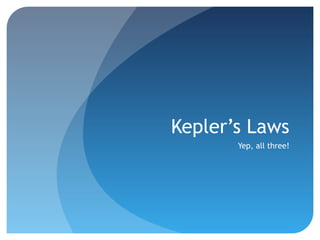Keplers laws
•Descargar como PPT, PDF•
1 recomendación•860 vistas
Denunciar
Compartir
Denunciar
Compartir

Recomendados
Más contenido relacionado
La actualidad más candente
La actualidad más candente (20)
Destacado
Destacado (12)
Similar a Keplers laws
Similar a Keplers laws (20)
Professor’s Questions Set 2Provide comprehensive answers to th.docx

Professor’s Questions Set 2Provide comprehensive answers to th.docx
physical science senior high school Q2 WEEK 1.pptx

physical science senior high school Q2 WEEK 1.pptx
Más de MrsKendall
Más de MrsKendall (17)
Isotopes, Lewis Dot Diagrams and Predicting Reactions

Isotopes, Lewis Dot Diagrams and Predicting Reactions
Último
This presentation was provided by William Mattingly of the Smithsonian Institution, during the third segment of the NISO training series "AI & Prompt Design." Session Three: Beginning Conversations, was held on April 18, 2024.Mattingly "AI & Prompt Design: The Basics of Prompt Design"

Mattingly "AI & Prompt Design: The Basics of Prompt Design"National Information Standards Organization (NISO)
This presentation was provided by William Mattingly of the Smithsonian Institution, during the fourth segment of the NISO training series "AI & Prompt Design." Session Four: Structured Data and Assistants, was held on April 25, 2024.Mattingly "AI & Prompt Design: Structured Data, Assistants, & RAG"

Mattingly "AI & Prompt Design: Structured Data, Assistants, & RAG"National Information Standards Organization (NISO)
Último (20)
Beyond the EU: DORA and NIS 2 Directive's Global Impact

Beyond the EU: DORA and NIS 2 Directive's Global Impact
Disha NEET Physics Guide for classes 11 and 12.pdf

Disha NEET Physics Guide for classes 11 and 12.pdf
Russian Escort Service in Delhi 11k Hotel Foreigner Russian Call Girls in Delhi

Russian Escort Service in Delhi 11k Hotel Foreigner Russian Call Girls in Delhi
Z Score,T Score, Percential Rank and Box Plot Graph

Z Score,T Score, Percential Rank and Box Plot Graph
Mattingly "AI & Prompt Design: The Basics of Prompt Design"

Mattingly "AI & Prompt Design: The Basics of Prompt Design"
social pharmacy d-pharm 1st year by Pragati K. Mahajan

social pharmacy d-pharm 1st year by Pragati K. Mahajan
Measures of Dispersion and Variability: Range, QD, AD and SD

Measures of Dispersion and Variability: Range, QD, AD and SD
Measures of Central Tendency: Mean, Median and Mode

Measures of Central Tendency: Mean, Median and Mode
Mattingly "AI & Prompt Design: Structured Data, Assistants, & RAG"

Mattingly "AI & Prompt Design: Structured Data, Assistants, & RAG"
Interactive Powerpoint_How to Master effective communication

Interactive Powerpoint_How to Master effective communication
Keplers laws
- 1. Kepler’s Laws Yep, all three!
- 2. Greek Observations Early Greeks were the first to truly notice the planets in our solar system. In fact, planets is Greek for wanderers. Greeks believed that the earth was spinning within a larger dome called the celestial sphere. Greeks believed in a geocentric model, where the earth is at the center.
- 3. Greek astronomer: Ptolemy Ptolemy believed, as other Greeks did, that Earth was at the center; however, he hypothesized that the planets were moving on flat planes. The Geocentric model was accepted as truth for nearly 1,500 years!
- 4. Copernican Revolution! Polish Astronomy, Nicolaus Copernicus helped to develop the heliocentric model, where the sun is at the center rather than the Earth. Many people had trouble accepting this model, even into the 1600’s!
- 5. Good old Galileo Galilei Because Galileo use the newly invented telescope, he was able to discover more than his predecessors. Galileo discovered 4 moons orbiting Jupiter (known as the Galilean Moons) Galileo also helped to support and develop the heliocentric model.
- 6. Tycho Brahe & Johannes Kepler Late 1500’s, Danish astronomer Tycho Brahe and his assistant Johannes Kepler worked over a 20 year period collecting data through observations of the night’s sky. After Brahe died in 1601, Kepler continued to analyze and study the data- from that came his 3 laws.
- 7. Kepler’s 1st Law Through his observations of Mars’s orbit, he discovered his first law: The Orbital path of the planets are NOT circular- they are an ellipse (oval shape). This discovery disproved the long help belief of circular orbits.
- 8. Kepler’s 2nd Law Kepler then discovered that the speed of a given planet changes as it revolves around the sun. The closer a planet is to the sun, the faster it moves. The farther away it is, the slower it moves.
- 9. Kepler’s 3rd Law Kepler also discovered that the time it takes a planet to orbit the sun and it’s average distance from the sun are directly related. The closer a planet is to the sun, the faster it’s revolution. The farther a planet is, the slower the revolution.
- 10. Kepler’s 3rd Law Kepler also discovered that the time it takes a planet to orbit the sun and it’s average distance from the sun are directly related. The closer a planet is to the sun, the faster it’s revolution. The farther a planet is, the slower the revolution.